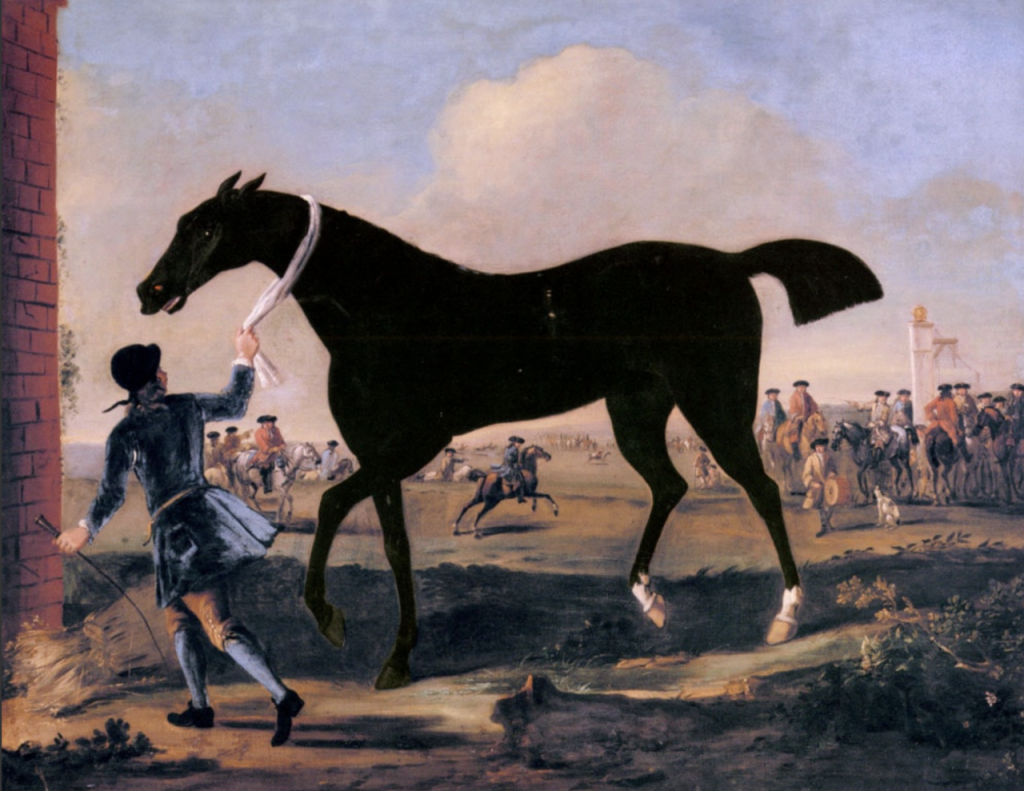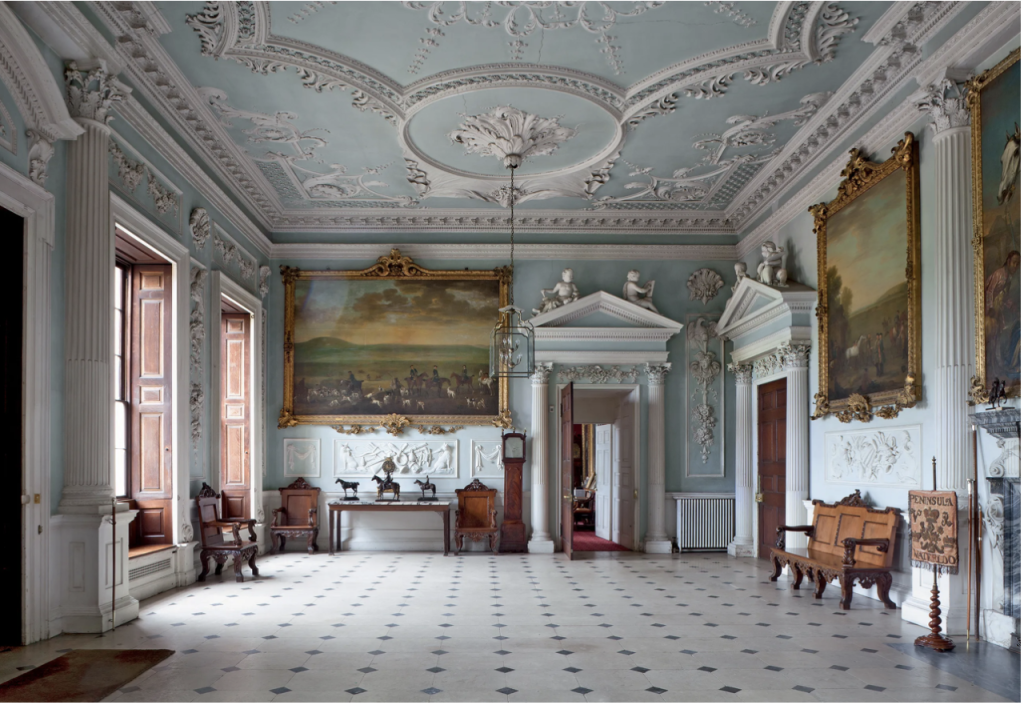
by Brooke Chilvers
On the trail of Great Britain’s “father of sporting art”
Few circumstances are more frustrating than reading about an interesting, even historically important, painting and not being able to pull up its image on the internet. Although the amount of information on art history on the Web has skyrocketed, some artists’ works remain elusive.
And so it is with British sporting and landscape artist John Wootton (1682?–1764), whose collectors came to him via word-of-mouth among the art-buying wealthy – royalty, noblemen, and landed gentry, along with some very rich barristers and bankers.
For us, this means that many of his most important monumental paintings, depicting hunting fox and stag on horseback and horse racing, as well as single-horse portraits of Newmarket thoroughbreds, and numerous favorite hunting dogs, remain out of sight to folks like us, locked behind the gates of very private country estates.
This also makes it difficult to know exactly which works are still where, and nearly impossible to track down good color images of described works, much less get permission to reproduce them. When images do appear, they are mostly small black-and-white photographs in older publications, with an occasional glimpse of Woottons hanging in the UK edition of House and Garden or Vogue.

Too cumbersome and customized to be removed for selling off by progeny of progeny, 300 years later, many of Wootton’s life-size horses and 7 feet x 10 feet hunts still hang in the magnificent halls of estates such as Longleat, Badminton, Welbeck, and Althorp.
Wootton’s patrons included Charles Spencer, 5th Earl of Sunderland and later 3rd Duke of Marlborough, who in 1734 ordered an entire series of enormous foxhunting scenes depicting his favorite hunters, the local gentry, and the many grooms, huntsmen, and hounds. They still hang in the two-story Palladian Great Hall entrance, “The Wootton Hall,” at Althorp, where Lady Diana Spencer was raised and is buried.
He painted seven hunting canvases of friends, family, hounds, and horses for Thomas Thynne, 2nd Viscount Weymouth’s Great Hall at Longleat. And in Badminton, seat of generations of Dukes of Beaufort, five monumental equestrian Woottons still dominate its rococo Great Hall.
Wootton’s circle of patrons grew to include the Dukes of Beaufort, Richmond, Bolton, Marlborough, Newcastle, Bedford, Rutland, Portland, and Leeds; the Earls of Oxford and Devonshire; Queen Anne and King George I (1660–1727); Queen Caroline and King George II (1683–1760), and his estranged son, Frederick, Prince of Wales; banker Henry II Hoare of Stourhead; and both the first Prime Minister, Sir Robert Walpole, 1st Earl of Orford for his Houghton Hall, and his son, man of letters and art historian, Horace Walpole.

Although the highest paid artist of his generation, next to nothing is known of Wootton’s origins. The year of his birth, in Snitterfield, near Stratford-on-Avon, is deduced from his being a longtime student in the 1690s of Dutch-born Jan Wyck (b. 1645–1702), “the Raphael of battle scenes.” It is surmised that Wootton started as a page at Snitterfield House to Lady Anne Somerset, Countess of Coventry (1673–1763) and daughter of the first Duke of Beaufort, who placed the young Wootton under Wyck’s tutelage.
Wootton’s life-changing moment was meeting Lord Edward Harley, later 2nd Earl of Oxford, in 1714. Harley would commission 40 paintings, and even become the artist’s landlord when Wootton moved from Soho to Cavendish Square in 1728. The colorful, arts-loving son of a powerful politician, Edward managed to wed Britain’s wealthiest heiress, Lady Henrietta Cavendish-Holles, sole inheritor of the 3rd Duke of Newcastle; but only after her father’s death and despite her mother’s vehement objections to Henrietta’s Welbeck Abbey and Wimpole Hall estates falling into the hands of her compulsive collector husband.

Edward’s library alone counted 50,000 books, 7,639 manuscripts and 41,000 prints – “the most choice and magnificent that were ever collected.” When forced by debt into selling his family home and extravagant accumulations, the Countess held on to the 21 Woottons in Welbeck’s collection (of which I can locate no photos), including several of herself hunting hare and hawking; alas, her heirs, through the 9th Duke of Portland, did sell off an equestrian portrait of their very own Lady Henrietta Harley.
Although equine anatomy was still in its infancy – George Stubbs’s The Anatomy of the Horse wasn’t published until 1766 – Wootton moved to Newmarket where he and his close followers, Peter Tillemans (1684–1734) and James Seymour (1702–1752), pioneered the Newmarket school of thoroughbred portraiture, just as interest in establishing and keeping track of pedigrees, bloodlines, and breeding was exploding.
Because he “sacrificed truth for beauty,” these are not exact renditions of specific horses, but rather flattering idealizations of the standard Arabian thoroughbred form. Still, Wootton is considered the first “graphic historian of Newmarket.” He used set pieces – the horse in classic full profile, held by a groom, with architectural details indicating the stables– at set places – The Warren Hill, The Heath, The Start and Finishing Posts, or Rubbing-Down House.

In 1715, Wootton painted his first known life-size horse portrait, of the perky jet-black racer, Bonny Black Held by a Groom at Newmarket, for John Manners, 2nd Duke of Rutland’s, Belvoir Castle. Not averse to painting the same subject several times, his second version, The Duke of Rutland’s Bonny Black, dated 1720, this time shows the cheerful groom facing the viewer and running in the opposite direction. He painted The Bloody-Shouldered Arabian up to 10 times for different owners, with the groom’s tunic, turban, and harem pants alluding to the thoroughbred’s pure Arabian blood.
As horseracing grew, so did demand for images of the most important horses, not just by proud owners but by racing fans and country gentlemen who collected depictions – even copies – by the same or another artist. In fact, one could commission an entire set of replicas of another patron’s collection without lifting eyebrows! Wootton’s not being averse to retouching or updating a 3rd Duke’s original to suit a 4th Duke’s taste sometimes makes it hard to date his paintings.
One would not be wrong to say that Wootton’s blood runs through all subsequent British landscape artists, from George Lambert to Gainsborough, Constable, and Turner. Yet the doors closed on Wootton and sporting art in general, when self-glorifying portraits of the rich and noble enjoying field sports fell out of favor.
To bring the very deserving John Wootton back into the limelight of British sporting and landscape art means opening some pretty big doors.
Brooke Chilvers could not track down a single image of the many Woottons reputedly still hanging in situ on the walls of Welbeck Abbey.
